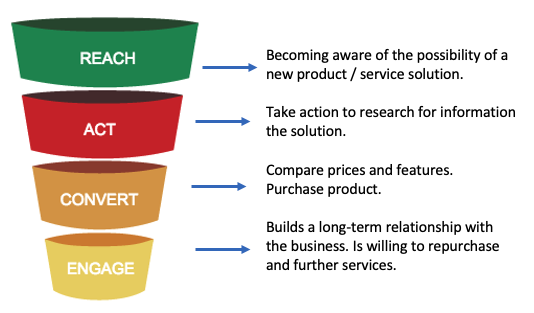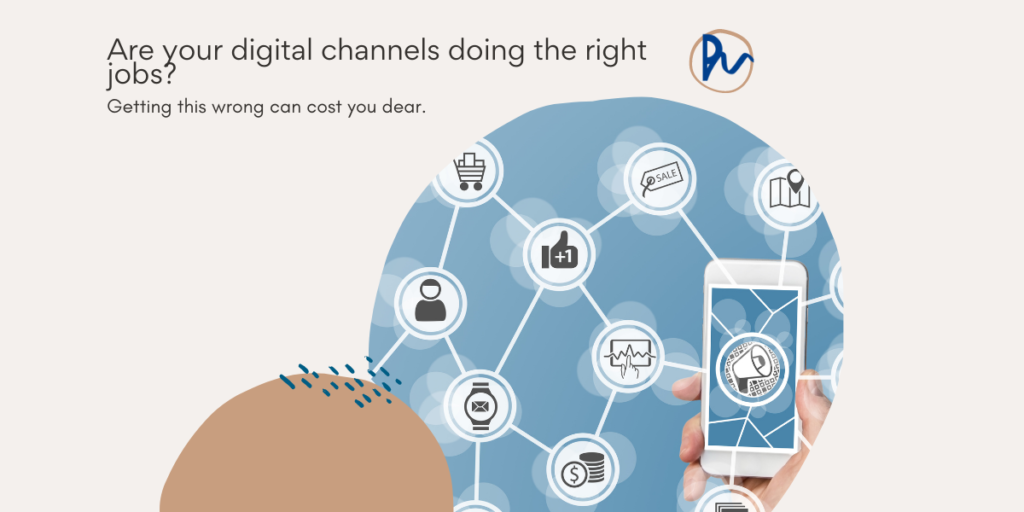It’s sad to think that many businesses just don’t know what value their digital channels are bringing to their bottom line.
In this article, I am going to look at two areas where businesses don’t understand the customer journey.
Business leaders can avoid digital marketing disappointment with your digital marketing by understanding how each channel used and carefully measuring success. One problem with your digital channels is that they are not created equal. Each channel has different strengths and weaknesses and does different jobs in the marketing process.
The RACE model is a simple visualization of the customer journey and the business needs to connect with potential customers at each stage. Recognizing each stage of the customer journey and providing what they need at that most essential to having a healthy flow of new business.

Two of the most common problems are:
Conversion myopia
But most businesses obsess with the conversion stage. Conversions are very important and should not be neglected, businesses are very concerned about getting visitors to their site to convert. And while this is understandable it the end of the day your digital marketing needs to yield a financial return.
Conversion Myopia is an over-focus on the conversion stage of the customer journey. Conversions are key to the success of any business and key to needs attention. These people are at the purchase stage of their customer journey. And if it’s not you, it’s going to be someone else. But this leads to the neglect of potential customers who earlier in their customer journey and are not yet ready to purchase. For example, they only just become aware of you and your products and want to learn more about you. (REACH stage). Or perhaps they are interested in purchasing and are comparing you with the competition (ACT STAGE).
Does your website provide them with the information and reassurance they are looking for?
If not, they will go someone who provides this information, and you will never get a chance to convert them.
Digital Channel Abuse
Digital Channel abuse occurs when a business uses its digital channels for purposes that they are not well suited. To repurpose this aphorism:
“If all you want to hit are nails (conversions), you need everything to become a hammer.”
Using digital channels for the wrong things leads to poor results, higher costs and general alarm and despondency with your digital marketing.
Two examples are the use of pay per click search advertising and social.
In the case of search advertising, I have seen businesses wanting to use their search advertising as a high funnel activity to increase awareness of their products and services.
There are a couple of problems with this approach. Firstly, search advertising requires a search. In other words, the user must already be aware of the product or service to search for it. Secondly, search advertising is relatively costly. It is not very useful for vague or general searches. Search advertising needs a strong purchase intent to be cost-effective. Sending a lot of low-quality traffic to the site just burns cash.
For social activities, it is the opposite problem. Social networks are very effective in making users aware of a new product or service. Very few of us go onto Facebook to watch adverts. They want to be informed and entertained. Businesses that try to sell to their social followers instead of communicating them are wasting a huge amount of time and energy. And more importantly, not giving value to their social community.
If you don’t believe me, visit a business page that focuses on its products and features, and you will see little or no engagement. That is very sad.
Creating A Digital Strategy: It’s horses for courses

When you are developing a digital strategy, you need to know where the different channels fit into the customer journey so that they are given the information and encouragement that they need to move to the next stage in the buying process.
The table above shows a Customer Journey Communications Model. At each Consideration Stage, the customers have a level of awareness, engagement and knowledge. So, for example, at the REACH stage, the customers have little knowledge of you and your products and have little incentive to investigate further, unless you provide them with compelling reasons to do so. There is little point explaining why you are better than Brand X if they have not heard you, your product or Brand X.
“Marketing focus” column looks at which digital channels are most effective in the different stages of the customer journey. As I mentioned above, Social Networks tend to be much more effective at the earlier consideration stages. Pay per Click is much more effective at the later stages of the journey when the potential customer knows what they are looking for and looking for the best options to purchase. Email is even further down the journey when the potential customer has become known to the business either as a prospect or a purchaser.
The Measurement column suggests some KPIs for the business to measure success.
Take-a-ways
Making sure that digital channels are targeted that the tasks that they are best suited to is essential to ensuring that your digital marketing is effective. Get this wrong and you are just burning cash.

